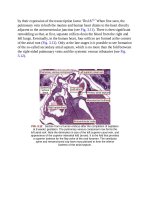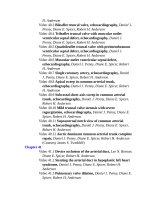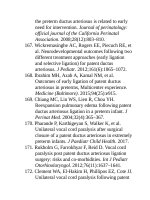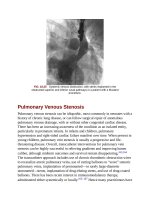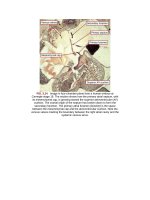Andersons pediatric cardiology 1030
Bạn đang xem bản rút gọn của tài liệu. Xem và tải ngay bản đầy đủ của tài liệu tại đây (124.3 KB, 3 trang )
FIG.39.2 Reconstructionsofcomputedtomographicdatasetsshowing
thearrangementintetralogyofFallot(left)anddouble-outletrightventricle
withthechannelbetweentheventriclespositionedbeneaththeaorticroot
(right).Theimagesshowhowtheplanedeemedtobethe“ventricular
septaldefect”inthesettingoftetralogy(redarrow)isanalogoustothearea
closedbythesurgeontoreconnecttheaorticrootwiththeleftventriclein
thesettingofdouble-outletrightventricle.Inthesettingoftetralogy,the
geometricinterventricularcommunication―whichisthecranialcontinuation
ofthelongaxisoftheapicalventricularseptum―separatestheconeof
spacesubtendedbeneaththeoverridingrootintorightventricularandleft
ventricularcomponents.Theleftventricularhalfisboundedbytheinner
heartcurvecraniallyandistheoutletfortheleftventricle(greenarrow).
Whenbotharterialtrunksarisefromtherightventricle,asshownatright,
theentirevolumesubtendedbytheaorticrootisalsorightventricular.The
geometricinterventricularcommunicationnowbecomestheoutletforthe
leftventricle.(CourtesyDrTonyHlavacek.)
Inlightoftheearlierdiscussions,itisquestionablewhetherthechannelfound
betweentheventricleswhenbotharterialtrunksarisefromtherightventricle
canjustifiablybecalledaventricularseptaldefect.5Thechannelcanneverbe
closedsurgically,unlessanalternativechannelisconstructedtoprovidethe
outletfromtheventriclenotdirectlysupportinganarterialtrunk.Throughout
thischapter,wedescribethechannelastheinterventricularcommunication
ratherthanaventricularseptaldefect,althoughwerecognizethatmostwill
continuetodescribeitinthelatterfashion.Moreimportantly,becauseofthe
markedphenotypicvariabilitycoupledwiththeadditionalvariationwithin
recognizedphenotypes,thecategorizationofeachcaseshouldbeindividualized.
Incomparablefashion,themedicalandsurgicalmanagementmustbetailoredto
caterfortheparticularproblemsoftheindividualpatient.Certainanatomic
combinations,nonetheless,dooccurwithsufficientfrequencytomeritspecific
discussion.12
Double-OutletRightVentricle
Themorecommonvariants,inapproximateorderoffrequency,areasfollows:
▪Thosewiththeinterventricularcommunicationin
subaorticposition,withtheaortaspiralingfromright
toleftrelativetothepulmonarytrunkbutin
combinationwithpulmonarystenosis.Thisisthe
Fallotvariant.
▪Thosewiththeinterventricularcommunicationin
subpulmonaryposition,withtheaortatotherightof
thepulmonarytrunkandparallelto,it.Thisisthe
Taussig-Bingvariant.
▪Thosewiththeinterventricularcommunicationin
subaorticposition,withtheaortaspiralingfromright
toleftrelativetothepulmonarytrunkbutinthe
absenceofpulmonarystenosis.
Lesscommonvariantsarethefollowing:
▪Thosewiththeinterventricularcommunication
uncommitted,ornoncommitted,toeithersubarterial
outletandwiththeaortatotherightofthepulmonary
trunk,witheitherspiralingorparallelarterialtrunks.
▪Thosewiththeinterventricularcommunicationin
doublycommittedposition,withtheaortatotheright
ofthepulmonarytrunkandspiralingarterialtrunks.
▪Thosewiththeinterventricularcommunicationin
subaorticpositionbutwiththeaortatotheleftofthe
pulmonarytrunkwithparallelarterialtrunks.
▪Thosewiththeusualatrialarrangementand
discordantatrioventricularconnections,usuallywith
theaortaparalleltoandtotheleftofthepulmonary
trunk.Becauseofthesignificanceofthediscordant
atrioventricularconnections,thisvariantisdiscussed
inChapter38.
▪Thosewithmirror–imagedatrialarrangementand
anyoftheabovevariations.
▪Thosewithisomericatrialappendagesand,hence,
mixedandbiventricularatrioventricularconnections.
ThesevariantsarediscussedinChapter26.
SpecificAnatomyoftheMoreCommonVariants
SubaorticInterventricularCommunication,Aorta
totheRightofthePulmonaryTrunk,Spiraling
ArterialTrunks,andPulmonaryStenosis
Thereisusuallyacompletemuscularinfundibulumsupportingeacharterial
valve(Fig.39.3A),althoughfibrouscontinuitybetweentheaorticand
atrioventricularvalvesisfoundinmanycases(seeFig.39.3B).The
subpulmonaryoutflowtractisnarrowed,typicallywithhypoplasiaofthe
infundibulum.Oftenthevalveisadditionallyinvolved.Theobstructivelesions
aresimilartothoseseenintetralogyofFallot.Theinterventricular
communication,cradledwithinthelimbsoftheseptomarginaltrabeculation,is
perimembranousinmostcases(seeFig.39.3),butcanhaveamuscular
posteroinferiorrim.
